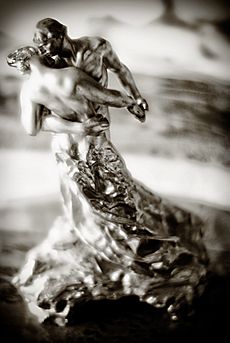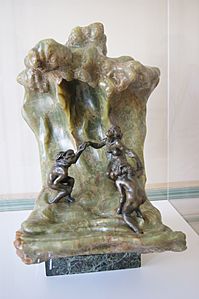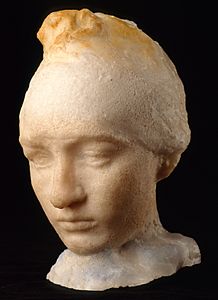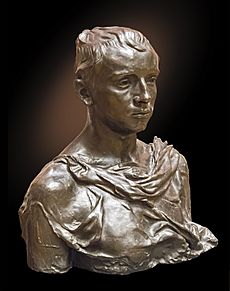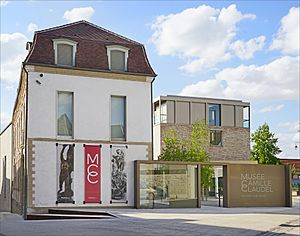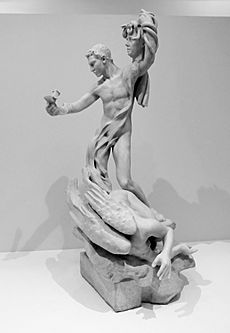Camille Claudel facts for kids
Quick facts for kids
Camille Claudel
|
|
|---|---|
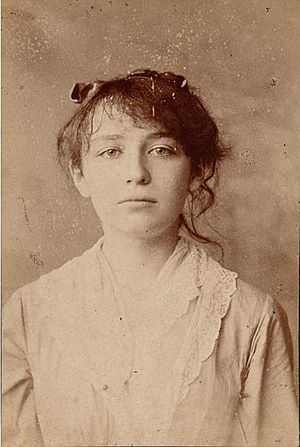
Claudel sometime before 1883
|
|
| Born |
Camille Rosalie Claudel
8 December 1864 |
| Died | 19 October 1943 (aged 78) Montdevergues, Vaucluse, Vichy France
|
| Nationality | French |
| Alma mater | Académie Colarossi |
| Occupation | Sculptor |
| Known for | Figurative artwork in bronze and marble |
|
Notable work
|
Sakuntala The Waltz The Mature Age List of sculptures |
| Relatives | Paul Claudel (brother) |
| Signature | |
 |
|
Camille Rosalie Claudel (French pronunciation: [kamij klodɛl] ; 8 December 1864 – 19 October 1943) was a French sculptor known for her figurative works in bronze and marble. She died in relative obscurity, but later gained recognition for the originality and quality of her work. The subject of several biographies and films, Claudel is well known for her sculptures including The Waltz and The Mature Age.
The national Camille Claudel Museum in Nogent-sur-Seine opened in 2017. Claudel was a longtime associate of sculptor Auguste Rodin, and the Musée Rodin in Paris has a room dedicated to her works.
Sculptures created by Claudel are also held in the collections of several major museums including the Musée d'Orsay in Paris, the Courtauld Institute of Art in London, the National Museum of Women in the Arts in Washington, D.C., the Philadelphia Museum of Art, and the J. Paul Getty Museum in Los Angeles.
Contents
Early years
Camille Claudel was born in Fère-en-Tardenois, Aisne, in northern France, the first child of a family of farmers and gentry. Her father, Louis-Prosper Claudel, dealt in mortgages and bank transactions. Her mother, the former Louise-Athanaïse Cécile Cerveaux, came from a Champagne family of Catholic farmers and priests. The family moved to Villeneuve-sur-Fère while Camille was still a baby. Her younger brother Paul Claudel was born there in 1868. Subsequently, they moved to Bar-le-Duc (1870), Nogent-sur-Seine (1876), and Wassy-sur-Blaise (1879), although they continued to spend summers in Villeneuve-sur-Fère, and the stark landscape of that region made a deep impression on the children.
From the ages of 5 to 12, Claudel was educated by the Sisters of Christian Doctrine. While living in Nogent-sur-Seine at age 12, Claudel began working with the local clay, regularly sculpting the human form.
As Camille grew older, she enriched her artistic education with literature and old engravings.
Her mother Louise did not approve of Claudel's "unladylike desire to become an artist." Her father was more supportive and took examples of her artwork to their artist neighbor Alfred Boucher, to assess her abilities. Boucher confirmed that Claudel was a capable, talented artist and encouraged her family to support her study of sculpture. Camille moved with her mother, brother, and younger sister to the Montparnasse area of Paris in 1881. Her father remained behind, working to support them.
Creative period
Study with Alfred Boucher
Claudel was fascinated with stone and soil as a child, and as a young woman she studied at the Académie Colarossi, one of the few places open to female students. Once in Paris, she studied with sculptor Alfred Boucher. The Académie Colarossi was more progressive than other arts institutions as it allowed female students at the school. At the time, the École des Beaux-Arts barred women from enrolling to study.
In 1882, Claudel rented a studio workshop on rue Notre-Dame des Champs in Paris that she shared with three British sculptors: Jessie Lipscomb, Emily Fawcett and Amy Singer (daughter of John Webb Singer, whose foundry in Frome, Somerset, made large-scale bronze statues.) Several prominent Frome works are in London, including the Boadicea group on the Embankment, Cromwell, which graces the lawn in front of the Houses of Parliament, and the figure of Justice atop the Old Bailey. General Gordon on his camel at Chatham Barracks was also cast in Frome, as were the eight lions that form part of the Rhodes Memorial in Cape Town. Claudel visited Frome and the families of her fellow sculptors. All of these English friends had studied at the South Kensington Schools – that would become the Royal College of Art – before moving to Paris to be at the Academie Colarossi, where they had all met. Claudel prolonged her stay with Singer's family in Frome.
Alfred Boucher had become Claudel's mentor, and provided inspiration and encouragement to the next generation of sculptors such as Laure Coutan. Claudel was depicted by Boucher in Camille Claudel lisant, and later she sculpted a bust of her mentor.
After teaching Claudel and the other sculptors for over three years, Boucher moved to Florence following an award for the Grand Prix du Salon. Before he left he asked Auguste Rodin to take over the instruction of his pupils. Rodin and Claudel met, and their artistic association and the tumultuous and passionate relationship soon began.
Auguste Rodin
Claudel started working in Rodin's workshop in 1883 and became a source of inspiration for him. She acted as his model and his confidante. Claudel also depended on him financially, especially after her loving and wealthy father's death, which allowed her mother and brother, who disapproved of her lifestyle, to maintain control of the family fortune and leave her to wander the streets dressed in beggars' clothing.
Her early work is similar to Rodin's in spirit but shows imagination and lyricism quite her own, particularly in the famous The Waltz (1893).
Louis Vauxcelles states that Claudel was the only sculptress on whose forehead shone the sign of genius like Berthe Morisot, the only well-known female painter of the century, and that Claudel's style was more virile than many of her male colleagues'. Others, like Morhardt and Caranfa, concurred, saying that their styles had become so different, with Rodin being more suave and delicate and Claudel being vehement with vigorous contrasts, which might have been one reason for their break up, with her becoming ultimately his rival.
Claudel's onyx and bronze small-scale La Vague (The Wave) (1897) was a conscious break in style from her Rodin period. It has a decorative quality quite different from the "heroic" feeling of her earlier work.
The Mature Age and other works
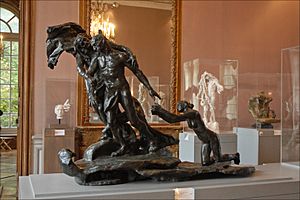
After Rodin saw Claudel's The Mature Age for the first time, in 1899, he reacted with shock and anger. He suddenly and completely stopped his support for Claudel. According to Ayral-Clause, Rodin might have put pressure on the ministry of fine arts to cancel the funding for the bronze commission.
The Mature Age (1900) is usually interpreted as an allegory of the three stages of life: the man who represents Maturity is drawn into the hands of the old woman who represents Old Age and Death, while the young woman who represents Youth tries to save him. Her brother interpreted it as an allegory of her break with Rodin. Angelo Caranfa comments that "The life that was, is, and will be in Maturity contains within its movement both the relentless movement of Clotho and the rhythmic, graceful, whirling movement of Fortune, generating a single and sustaining movement or image out of the differences within" . According to Caranfa, Clotho (1893) and Fortune (1905) represent the two ideas of life: life in Clotho is portrayed as closed, hopeless existence and "consummated in an unending death"; life in Fortune is celebrated as the madness of eternal present with ups and downs, its "rapture or total harmony" (Fortune itself is a variation of the dancing woman in The Waltz).
One of Claudel's figures, The Implorer, was produced as an edition of its own and has been interpreted not as purely autobiographical but as an even more powerful representation of change and purpose in the human condition. Modelled for in 1898 and cast in 1905, Claudel didn't actually cast her own bronze for this work, but instead The Implorer was cast in Paris by Eugene Blot.
In 1902 Claudel completed a large sculpture of Perseus and the Gorgon. Beginning in 1903, she exhibited her works at the Salon des Artistes français or at the Salon d'Automne.
Sakuntala, 1888, is described by Angelo Caranfa as expressing Claudel's desire to reach the sacred, the fruit of the lifelong search of her artistic identity, free from Rodin's constraints. Caranfa suggests that Claudel's impressions of Rodin's deceptions and exploitation of her, as someone who could not become obedient as he wanted her to be and who was expected to conform to society's expectation of what women should be, were not false. Thus Sakuntala could be called a clear expression of her solitary existence and her inner search, her journey within.
Ayral-Clause says that even though Rodin clearly signed some of her works, he was not treating her as different because of her gender; artists at this time generally signed their apprentices' work. Others also criticise Rodin for not giving her the acknowledgment or support she deserved. Walker argues that most historians believe Rodin did what he could to help her after their separation, and that her destruction of her own oeuvre was partly responsible for the long-time neglect the art world showed her. Walker also says that what truly defeated Camille, who was already recognised as a leading sculptor by many, were the sheer difficulties of the medium and the market: sculpting was an expensive art, and she did not receive many official commissions because her style was highly unusual for the contemporary conservative tastes. Despite this, Le Cornec and Pollock believe she changed the history of arts.
Other authors write that it is still unclear how much Rodin influenced Claudel – and vice versa, how much credit has been taken away from her, or how much he was responsible for her woes. Most modern authors agree that she was an outstanding genius who, starting with wealth, beauty, iron will and a brilliant future even before meeting Rodin, was never rewarded and died in loneliness, poverty, and obscurity. Others like Elsen, Matthews and Flemming suggest it was not Rodin, but her brother Paul who was jealous of her genius, and that he conspired with her mother, who never forgave her for her supposed immorality, to later ruin her and keep her confined to a mental hospital. Kavaler-Adler notes that her younger sister Louise, who desired Camille's inheritance and was also jealous of her, was delighted at her sister's downfall.
Less well known than her love affair with Rodin, the nature of her relationship with Claude Debussy has also been the object of much speculation. Stephen Barr reports that Debussy pursued her: it was unknown whether they ever became lovers. They both admired Degas and Hokusai, and shared an interest in childhood and death themes. When Claudel ended the relationship, Debussy wrote: "I weep for the disappearance of the Dream of this Dream." Debussy admired her as a great artist and kept a copy of The Waltz in his studio until his death. By thirty, Claudel's romantic life had ended.
-
Head of Camille Claudel, 1884, by Auguste Rodin, portrays Claudel wearing a Phrygian cap, on exhibit at the Museo Soumaya
Alleged mental illness and confinement
After 1905, Claudel appeared to be mentally ill. She destroyed many of her statues, disappeared for long periods of time, exhibited signs of paranoia and was diagnosed as having schizophrenia. She accused Rodin of stealing her ideas and of leading a conspiracy to kill her. After the wedding of her brother in 1906 and his return to China, she lived secluded in her workshop. Claudel's father approved of her career choice, and he tried to help and support her financially. But when he died on 2 March 1913, Claudel was not informed of his death. Instead, eight days later, on 10 March 1913, at the request of her younger brother Paul, she was admitted to the psychiatric hospital of Ville-Évrard in Neuilly-sur-Marne.
The form read that she had been "voluntarily" committed, although her admission was signed only by a doctor and her brother. There are records to show that, while she did have mental outbursts, she was clear-headed while working on her art. Doctors tried to convince Paul and their mother that Claudel did not need to be in the institution, but they still kept her there. According to Cécile Bertran, a curator from the Musée Camille Claudel, the situation was not easy to judge, because modern experts who have looked at her records say she was indeed ill.
In 1914, to be safe from advancing German troops, the patients at Ville-Évrard were at first relocated to Enghien. On 7 September 1914 Claudel was transferred with a number of other women, to the Montdevergues Asylum, at Montfavet, six kilometres from Avignon. Her certificate of admittance to Montdevergues was signed on 22 September 1914; it reported that she suffered "from a systematic persecution delirium mostly based upon false interpretations and imagination".
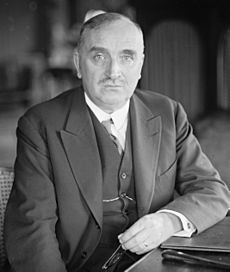
For a while, the press accused her family of committing a sculptor of genius. Her mother forbade her to receive mail from anyone other than her brother. The hospital staff regularly proposed to her family that Claudel be released, but her mother adamantly refused each time. On 1 June 1920, physician Dr. Brunet sent a letter advising her mother to try to reintegrate her daughter into the family environment. Nothing came of this. Paul Claudel visited his confined older sister seven times in 30 years, in 1913, 1920, 1925, 1927, 1933, 1936, and 1943. He always referred to her in the past tense. Their sister Louise visited her just one time in 1929. Her mother, who died in June 1929, never visited Claudel.
In 1929 sculptor and Claudel's former friend Jessie Lipscomb visited her, and afterwards insisted "it was not true" that Claudel was insane. Rodin's friend, Mathias Morhardt, insisted that Paul was a "simpleton" who had "shut away" his sister of genius.
Camille Claudel died on 19 October 1943, after having lived 30 years in the asylum at Montfavet (known then as the Asile de Montdevergues, now the modern psychiatric hospital Centre hospitalier de Montfavet). Her brother Paul had been informed of his sister's terminal illness in September and, with some difficulty, had crossed Occupied France to see her, although he was not present at her death or funeral. Her sister did not make the journey to Montfavet.
Claudel was interred in the cemetery of Montfavet, and eventually her remains were buried in a communal grave at the asylum. From the 2002 book, Camille Claudel, A Life: "Ten years after her death, Camille's bones had been transferred to a communal grave, where they were mixed with the bones of the most destitute. Joined forever to the ground she tried to escape for so long, Camille never, ever, returned to her beloved Villeneuve. Paul's neglect regarding his sister's grave is hard to forgive...while Paul decided not to be burdened with his sister's grave, he took great pains, on the contrary, in choosing his own final resting place, naming the exact location – in Brangues, under a tree, next to his grandchild – and citing the precise words to be written on the stone. Today his admirers pay homage to his memory at his noble grave; but of Camille there is not a trace. In Villeneuve, a simple plaque reminds the curious visitor that Camille Claudel once lived there, but her remains are still in exile, somewhere, just a few steps away from the place where she was sequestered for thirty years."
Legacy
Musée Camille Claudel
The Musée Camille Claudel was opened in March, 2017, as a French national museum dedicated to Claudel's work. It is located in her teenage home town of Nogent-sur-Seine. The Musée Camille Claudel displays approximately half of Claudel's 90 surviving works.
Plans to turn the Claudel family home at Nogent-sur-Seine into a museum were announced in 2003, and the museum negotiated with the Claudel family to buy Camille's works. These include 70 pieces, including a bust of Rodin.
Surviving works
Though she destroyed much of her work, about 90 statues, sketches and drawings survive. In 1951, Paul Claudel organised an exhibition at the Musée Rodin, which continues to display her sculptures. A large exhibition of her works was organised in 1984. In 2005 a large art display featuring the works of Rodin and Claudel was exhibited in Quebec City (Canada), and Detroit, Michigan, in the US. In 2008, the Musée Rodin organised a retrospective exhibition including more than 80 of her works.
In 2005, Sotheby's sold a second edition La Valse (1905, Blot, number 21) for $932,500. In a 2009 Paris auction, Claudel's Le Dieu Envolé (1894/1998, foundry Valsuani, signed and numbered 6/8) had a high estimate of $180,000, while a comparable Rodin sculpture, L'éternelle Idole (1889/1930, Rudier, signed) had a high estimate of $75,000.
See also
 In Spanish: Camille Claudel para niños
In Spanish: Camille Claudel para niños
- List of sculptures by Camille Claudel
- Camille Claudel, 1988 biographical fictional film with Isabelle Adjani (Camille) and Gérard Depardieu (Rodin), France, nominated for two Academy Awards
- Camille Claudel, 2003 musical
- Camille Claudel 1915, 2013 French biopic written and directed by Bruno Dumont, starring Juliette Binoche as Camille Claudel.
- Rodin, 2017 film, with Izïa Higelin portraying Claudel.


